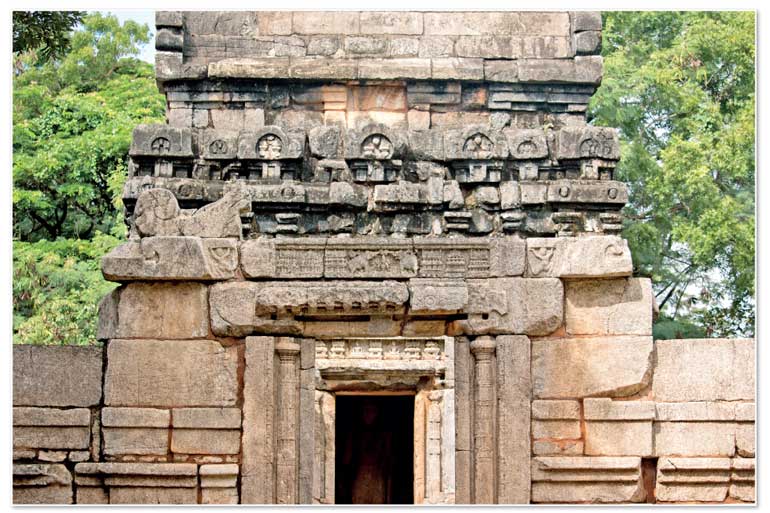Friday Mar 21, 2025
Friday Mar 21, 2025
Saturday, 18 November 2017 00:05 - - {{hitsCtrl.values.hits}}
 By Aysha Maryam Cassim
By Aysha Maryam Cassim
Nalanda Gedige is a monolithic structure entirely vaulted from brick where you could see an infusion of Hindu and Buddhist architectural elements.
Gedige is a word derived from Pali, which roughly means a brick house, which is used to shelter images. The architectural uniqueness of Nalanda Gedige is intriguing. It has a charm of its own that should be witnessed by anyone who has a curiosity for mystery and history.
The little-known solitary shrine in Matale
Although not included in the tourist circuits, it’s worth taking a diversion on your way to Dambulla from Kandy to visit this little known solitary shrine. The temple is located 20km south of the Dambulla Temple and about one kilometre east of the main Jaffna-Kandy A9 Road. It will only take you less than half an hour to visit the temple. It is also one of the few places in Sri Lanka where you can visit a historically significant site without paying an entrance fee. The temple shrine is currently managed by the Archaeological Department of Sri Lanka.
The promenade that leads you to the shrine is shrouded with foliage and trees. The temple site is nestled in a secluded arboreal village, surrounded by a reservoir. The stone pillars on either side of the path will lead you to the sight of a massive ‘Vimana’ – a vault with intricate stone carvings. Before you begin your short excursion, make sure to visit the museum located at the car park. A guide will provide an explanation of the carvings and Brahmi inscriptions on rectangular stone slabs.
The legend of the Hidden Temple
Nalanda Gedige was hidden in the forest for centuries until it was finally unearthed by British Archaeologist Bell in 1893. Once the surface ornaments and sculptures were dug around, the temple was reassembled from its remnants in 1975.
The shrine was originally located in a lower level terrace of mushy paddy fields and due to the Mahaveli River hydroelectricity project – Bowatenna Tank, the site faced the threat of a submerge. In 1980, Nalanda Gedige was dismantled, moved and meticulously reconstructed on a higher ground.
The construction
Its construction is ambiguously dated by many archaeologists. According to some associated inscriptional evidence of 8-9th century, former Archaeological Commissioner Prof. Senerath Paranavitana assigned this temple to late Pallava style of about 8th century. It is believed that the site was fortified by King Parakramabahu in the second half of the 12th century and endowed with a monastery between the eighth and 10th century.

The design
Presumably built in 11th century AD, the Gedige is considered to have been a sanctuary dedicated to Mahayana chapter with pronounced Tantric learnings. At first glance, the temple bears much resemblance to a Hindu shrine. It has very little in common with Classic Sinhalese-Buddhist architecture.
“The ground plan, materials used in the construction and greater part of ornamentation have no parallels in the architecture of Anuradhapura era” – Sinhalese Monastic Architecture by S.D. Bandaranayake.
The Cholas reigned over ancient Sri Lanka for three generations. Stone temples in Dravidian design proliferated in Polonnaruwa during this period. Artists emulated structures from solid brick mass to construct the finest monastic complexes. They embellished the façades and stone columns with Shaivite and Vaishnavite details. Just as any South Indian shrine, you could see Hindu motifs and deities such as Ganesha, Lakshmi, and Kuvera adorning Nalanda Gedige’s image house.
The temple consists of a Mandapaya and Vimana, the structure over the garbhagriha or inner sanctum. The Sikhara, a dome-shaped crowning cap above the Vimana, is an architectural marvel. The pillared antechamber is surrounded by an ambulatory. The image shrine houses a standing Buddha, a statue of Ganesha and a Bodhisattva figure.
Unusual carvings
The carving of the God of wealth, Kuvera, appears to be squatting on a lotus plinth, on the south side of the tympanum over the sanctuary. This is the only image of Kuvera to be found in Sri Lanka.
The most interesting motif in the Gedige is the erotic Tantric carving known as ‘Manava Maithunyaya,’ which depicts the sexual union of a lion and two men. A similar sexual theme can be seen in the sculptures of Khajuraho temple in India.
Art is regarded as a part of Hindu tradition of treating kama (sexual desire). Hence, we could assume that this symbolism was embedded in the carvings of Nalanda Gedige under the strong South Indian influence.
Discover Kapruka, the leading online shopping platform in Sri Lanka, where you can conveniently send Gifts and Flowers to your loved ones for any event including Valentine ’s Day. Explore a wide range of popular Shopping Categories on Kapruka, including Toys, Groceries, Electronics, Birthday Cakes, Fruits, Chocolates, Flower Bouquets, Clothing, Watches, Lingerie, Gift Sets and Jewellery. Also if you’re interested in selling with Kapruka, Partner Central by Kapruka is the best solution to start with. Moreover, through Kapruka Global Shop, you can also enjoy the convenience of purchasing products from renowned platforms like Amazon and eBay and have them delivered to Sri Lanka.
Discover Kapruka, the leading online shopping platform in Sri Lanka, where you can conveniently send Gifts and Flowers to your loved ones for any event including Valentine ’s Day. Explore a wide range of popular Shopping Categories on Kapruka, including Toys, Groceries, Electronics, Birthday Cakes, Fruits, Chocolates, Flower Bouquets, Clothing, Watches, Lingerie, Gift Sets and Jewellery. Also if you’re interested in selling with Kapruka, Partner Central by Kapruka is the best solution to start with. Moreover, through Kapruka Global Shop, you can also enjoy the convenience of purchasing products from renowned platforms like Amazon and eBay and have them delivered to Sri Lanka.